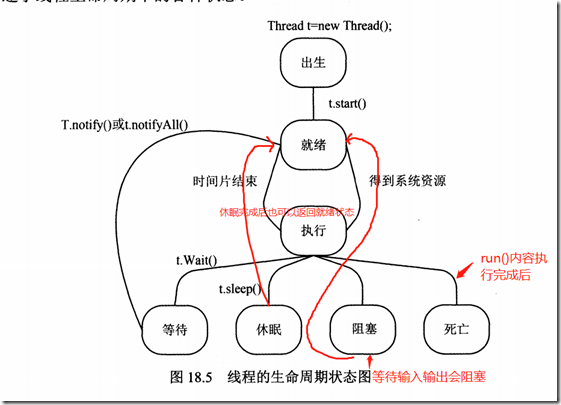5.JAVA语言基础部分—多线程
一个应用有一个进程,一个进程里可以用多个线程
1)定义
定义线程有两种方式,一是继承java.lang.Thread类,二是实现java.lang.Runnable接口。其实Thread类就是实现了Runnable接口的。
1 2 3 4 5 6 7 8 9 10 11 12 13 14 15 16 17 18 | //方法一:继承Thread,并重写run()public class OrdersThread extends Thread { //该类实例化时并不会立即执行run(),而是在实例上调用start()才会执行 @Override public void run() { //需要线程执行的内容放在run方法 for (int i = 0; i < 10; i++) { System.out.println(i); } }} //调用 public static void main(String[] args) { OrdersThread ot=new OrdersThread(); //调用start()才真正开始线程 ot.start(); } |
方法二:
1 2 3 4 5 6 7 8 9 10 11 12 13 14 15 16 | //方法二实现接口Runnablepublic class MyRunnable implements Runnable{ @Override public void run() { // 这里放需要执行的代码 }}// 调用 public static void main(String[] args) { MyRunnable ta = new MyRunnable(); //通过实现Runnable接口方式,需要使用Thread实现来启动 Thread thread1 = new Thread(ta); thread1.start(); } |
方法三:Runnable方式还可以通过匿名类的写法实现
1 2 3 4 5 6 7 8 9 | public static void main(String[] args) { //匿名类实现的方式,匿名类实现接口Runnable Thread thread2=new Thread(new Runnable() { @Override public void run() { //需要执行的代码 } }); } |
2)线程生命周期
Thread.sleep(毫秒值):进入休眠,单位毫秒。线程不会释放对象锁,不让出系统资源,占用着。直接使用Thread类调用sleep,不用实例。谁调用谁睡觉去,即使在当前线程调用别的线程的sleep,睡觉的不是当前线程,其他线程不受影响。sleep的唤醒要等时间到了自动醒过来,如果时间不到只能调用它的实例的interrupt()强行中断。
wait():也是等待,一般不需要指定时间,需要使用notify()/notifyAll()来唤醒。它跟sleep不同,wait是释放对象锁的,不占资源,一般是用到同步模块(synchronized)中去。如下面所示,也有多线程同步的写法;
1 2 3 4 5 6 7 8 9 10 11 12 13 14 15 16 17 18 19 20 21 22 23 24 25 26 | public class MyRunnable implements Runnable { private static String flag=""; @Override public void run() { //多线程同步 //这里可以定义一个变量,或者使用当前类this,或空格“” 都可以 synchronized (flag) { //这里notify()是唤醒当前MyRunnable的上一个实例继承执行(上次实例中wait()后面的代码继承执行) //这里notifyAll()是唤醒当前MyRunnable的【所有所有所有】实例中有wait()的实例继承执行 //只能在当前的run调用notity,其它地方行 flag.notify(); for (int i = 1000; i < 1100; i++) { if (i == 1050) { try { System.out.println("MyRunnable暂停了"); flag.wait(); } catch (InterruptedException e) { e.printStackTrace(); } } System.out.println(i); } } }} |
3)线程加入
有两个线程A、B,在执行A时某一步骤时要先让B执行完后再继续执行A,可以使用join()
1 2 3 4 5 6 7 8 9 10 11 12 13 14 15 16 17 18 19 20 21 22 23 24 25 26 27 28 29 30 31 32 33 34 35 36 37 38 39 40 41 42 43 44 45 | package com.test;import java.lang.annotation.Annotation;import java.lang.reflect.Constructor;import java.util.ArrayList;import java.lang.reflect.*;public class Main { //定义未赋值的变量放在外面 private static Thread a; private static Thread b; public static void main(String[] args) { a = new Thread(new Runnable() { public void run() { for (int i = 10; i < 20; i++) { try { Thread.sleep(100); print(i); if (i == 12) { //到此处时,只有b完成后才会继续往下走 b.join(); } } catch (InterruptedException e) { e.printStackTrace(); } } } }); a.start(); b = new Thread(new Runnable() { public void run() { for (int i = 30; i < 40; i++) { try { Thread.sleep(100); } catch (InterruptedException e) { e.printStackTrace(); } print(i); } } }); b.start(); }} |
4)线程中断
方法一:在线程继承类或实现Runnable接口的类里定义一个变量,然后在run()处判断该变量值为多少时就使用break;退出。该方法有限制,当线程里使用了sleep()或wait()后就无法退出了,此时应使用方法interrup()退出。
方法二:强行中断线程使用interrup(),调用线程的实例的interrup()方法,线程执行处就会抛出异常InterruptedException,使用try catch捕获使用break退出即可。
1 2 3 4 5 6 7 8 9 10 11 12 13 14 15 16 | public class OrdersThread extends Thread { @Override public void run() { for (int i = 0; i < 10; i++) { if(i==5) try { Thread.sleep(1000); } catch (InterruptedException e) { //只要在run()里使用try catch捕获InterruptedException异常,然后使用break处理并退出了 System.out.println("强行退出了"); break; } System.out.println(i); } }} |
1 2 3 | OrdersThread t3=new OrdersThread(); t3.start(); t3.interrupt();//实例里强行退出 |
5)线程优先线
线程优先级有常数:1-10,默认为5
使用setPriority(1~10的整数)
1 2 3 4 5 6 7 8 9 | OrdersThread t3=new OrdersThread(); //注意值的范围是1-8 t3.setPriority(8); //也可以使用预先定义的枚举指定 //t3.setPriority(Thread.NORM_PRIORITY); t3.setName("线程名称");//这里设置线程名称的写法 //最后才能start t3.start(); |
6)线程同步
1 2 3 4 5 6 7 8 9 10 11 12 13 | public class MyRunnable implements Runnable { @Override public void run() { // Object可以是任何,一般是定义一个静态变量,或者当前类实例 synchronized (Object) { // 需要步的代码 for (int i = 1000; i < 1100; i++) { System.out.println(i); } } }} |
线程同步方法
1 2 3 4 | //同步方法使用synchronized修饰 public synchronized String getName() { return ""; } |






【推荐】国内首个AI IDE,深度理解中文开发场景,立即下载体验Trae
【推荐】编程新体验,更懂你的AI,立即体验豆包MarsCode编程助手
【推荐】抖音旗下AI助手豆包,你的智能百科全书,全免费不限次数
【推荐】轻量又高性能的 SSH 工具 IShell:AI 加持,快人一步
· .NET Core 中如何实现缓存的预热?
· 从 HTTP 原因短语缺失研究 HTTP/2 和 HTTP/3 的设计差异
· AI与.NET技术实操系列:向量存储与相似性搜索在 .NET 中的实现
· 基于Microsoft.Extensions.AI核心库实现RAG应用
· Linux系列:如何用heaptrack跟踪.NET程序的非托管内存泄露
· TypeScript + Deepseek 打造卜卦网站:技术与玄学的结合
· 阿里巴巴 QwQ-32B真的超越了 DeepSeek R-1吗?
· 【译】Visual Studio 中新的强大生产力特性
· 10年+ .NET Coder 心语 ── 封装的思维:从隐藏、稳定开始理解其本质意义
· 【设计模式】告别冗长if-else语句:使用策略模式优化代码结构